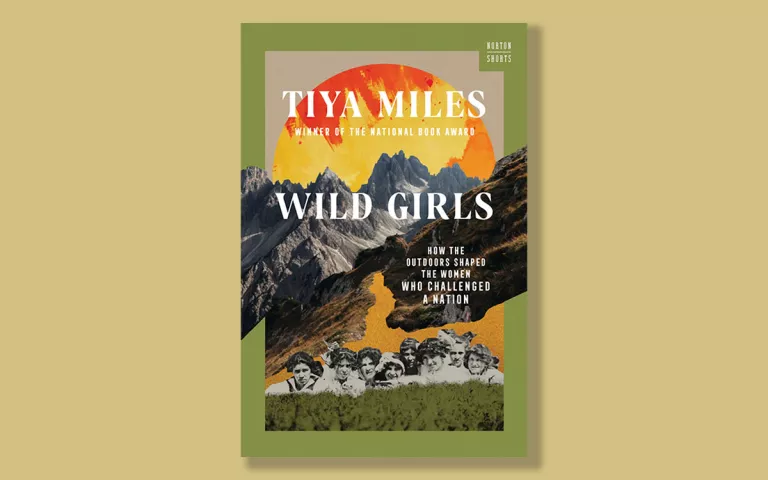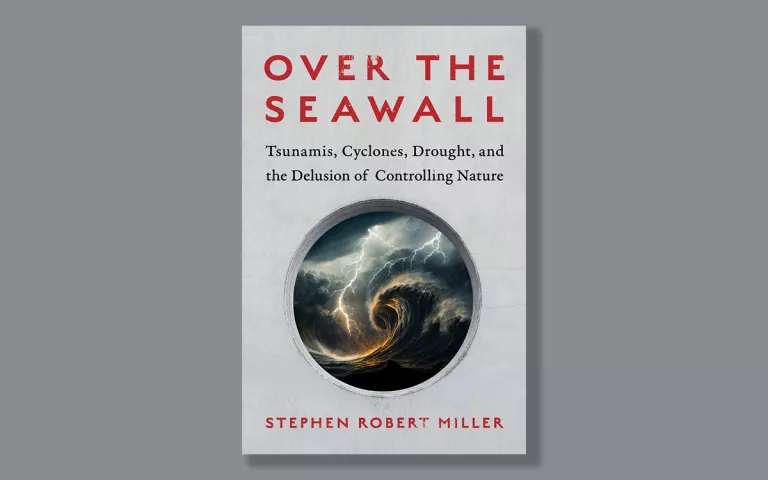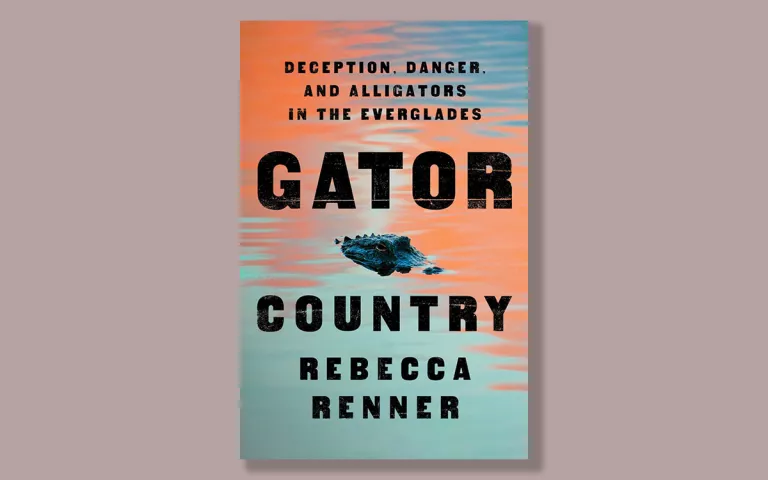3 Must-Read Books to Kick Off the New Year
These stories deepen our relationship with the wild world around us

Photo by ismail yonca/iStock
There is no better way to start a new year than with books that get you thinking about and relating to the world around you in a deeper way. How did the outdoors shape some of America's most accomplished female leaders? As the climate changes, can we plan for a more resilient future while avoiding the mistakes of the past? What can the Everglades teach us about the importance of cultivating balance and equilibrium with the natural world? These three books of nonfiction offer up the possible answers.

Wild Girls: How the Outdoors Shaped the Women Who Challenged a Nation
By Tiya Miles
W.W. Norton, 2023
Among environmentalists, it’s taken as an article of faith that time spent outdoors can shape people for the best. This supposed power goes far deeper than nature as balm—the pandemic-era meme that “nature is healing,” a fact convincingly confirmed by the latest neuroscience. Environmentalists often make a bigger claim that outdoor experiences, especially childhood outdoor experiences, can cultivate the virtues of independence, resilience, courage, and fortitude—as well as the moral instinct of empathy. The wild, or so the idea goes, can be a crucible of character.
But how does this alchemy work? How do childhood interactions with wind, water, and wild spaces transmute into personal values?
In her captivating new book Wild Girls: How the Outdoors Shaped the Women Who Challenged the Nation, Harvard professor and environmental educator Tiya Miles approaches such ideas via the biographies of female American leaders—enslaved heroines, pathbreaking writers, and Indigenous athletes—who had formative experiences in the wild. “Girl outsiders became trailblazers in their communities and American culture writ large,” Miles argues. “The stories pressed into this book like wildflower petals will show how time spent outside shaped the character of girls who later changed the country.”
Miles’s muse—her north star, you might say—is Harriet Tubman, the once-enslaved woman who led scores of people to freedom along the Underground Railroad and who later became a scout for the Union Army during the Civil War. As Miles shows, Tubman’s daring missions would not have succeeded without her impressive woodcraft, skills she learned as a child forced to work outdoors. Miles, though, seeks to make a bigger case: that Tubman’s love of and experience with nature was the source of her courage and the origin of a deep sense of personal freedom and individual agency that couldn’t be contained by the laws and mores that considered her mere property. As an adult, Tubman would say that she “grew up like a neglected weed.” And weeds, as Miles points out, are “hardy, persistent, and resilient,” and they “have no awareness of bondage and freedom.”
Through their encounters with the forces of nature, Tubman and other enslaved women like Kate Drumgoold, who wrote a brief memoir titled A Slave Girl’s Story, developed a moral intuition that the institution of slavery was unnatural. For many enslaved people, a moment of epiphany came overnight on November 12 and 13, 1833, when the Leonid meteor storm seemed to pour stars down upon the earth, as if the firmament was coming undone. The spectacle was mind-blowing. “For both girls,” Miles writes, “the sky above could be a source of comfort and terror, even as it offered ultimate proof that human masters did not control the earth and everything upon it.” The stars may have liberated Harriet Tubman’s mind before she herself liberated her body.
Close encounters with nature also helped mold the values and worldviews of some white girls in the North who would grow up to become abolitionists and suffragists, Miles argues. One of the most famous of these was the author and activist Louisa May Alcott, who wrote Little Women. Alcott grew up in Concord, Massachusetts, the epicenter of the transcendentalist intellectual scene and abolitionist politics; Henry David Thoreau was her sometime tutor and frequent companion. But if abolitionist sentiment was in the water of mid-19th-century Concord, even the most free-thinking men had very firm ideas of a woman’s place—and that place was usually the kitchen.
Alcott, a self-described tomboy, rebelled against such gender norms at an early age. Her rebellion took place outdoors. As she would later recall, she loved to “run wild, learning of nature what no books could teach.” Walden Pond and the woods surrounding Concord were places unbound by Victorian sensibilities, and lack of adult surveillance provided the freedom of gender fluidity. “By plunging outside, seizing the ‘rough and tumble’ of life and circumventing gender norms, Louisa May Alcott found a unique authorial voice,” Miles writes. That author’s most memorable creation was Jo March, the central figure of Little Women, who Miles calls “a revolutionary character and a proto-feminist figure.” It’s widely understood that Jo is a stand-in for Alcott herself. The much-beloved “gender rebel” that is Jo March was born of one girl’s mud-splattered childhood.
Miles goes on to profile another set of gender rebels: a group of Indigenous young women who, at the turn of the last century, garnered national fame for their unmatched skill at the then-new game of basketball. If white women’s lives in the 19th century were constricted by gender bias, Native women’s experience was doubly so—gender bias compounded by racial animus and the drive to “civilize” Indigenous people. The most repressive manifestation of these forces were the infamous Indian boarding schools, where Indigenous children suffered through daily routines and physical abuse marked by military precision. At the Fort Shaw Indian School in Montana, however, a small number of Indigenous young women (Blackfeet, Lakota, Dakota, and Métis) found a measure of liberation via basketball as they came to learn that “movement was a form of freedom.”
The Fort Shaw basketball team was a phenomenon. Traveling across the Northern Plains and as far away as St. Louis, the all-women’s squad demolished one competitor after another, men’s teams as well as women’s teams. Miles is unflinching about the contradictions of the spectacle; the Fort Shaw basketball players, she says, “performed their own assimilation before white crowds.” Yet she also makes a compelling case that the sport allowed the players to reclaim some portion their female Indigeneity, an identity rooted in a “sense of bold, kinesthetic movement that could belong to girls and women outside.” According to the Dakota educator Ella Deloria, the Native American “great-grandmother seemed to have unusual vitality and endurance; it could not have been otherwise.” On the basketball court, the young women of Fort Shaw got the chance to exhibit some of that vitality and endurance via what Miles calls “a holistic physicality outdoors.” Sport became an expression of resistance.
These are wonderful, inspiring stories, and Miles delivers them with verve. A winner of the National Book Award and a MacArthur fellow, Miles is a scholar’s scholar, and her capsule biographies are rich with detail and spiked with insight and revelation. But, in the end, the stories don’t fully deliver on the promise of the premise that time outdoors is necessarily character-forming. Is it really true that childhood experiences outside were the foundation of these heroines’ adult accomplishments? Correlation isn’t causation, and it seems just as likely that the connection between these women’s achievements and their youthful environs is a case of mere coincidence.
Many of Miles’s stories touch only briefly on her protagonists’ youthful connection to nature, then pivot to the subjects’ broader life histories. The tale of the Native American basketball stars is especially thin in this respect. We hear of “prairie girls” that expressed a “rhetoric of wildness,” but it’s a thin reed on which to hang the larger argument.
It seems to me that the biggest hurdle to proving a nature-and-character connection is the timeframe of this book. In the 19th century, just about every American girl—regardless of geography, class, ethnicity, or formal citizenship status—spent their girlhoods in intimate contact with wild nature. That’s just how people lived; when the 1860 census was conducted, 80 percent of Americans resided in rural areas. Some of them—Tubman, Alcott—may have had ecstatic experiences that broadened their horizons or radicalized their vision. Most did not. For many girls, we can reliably imagine, a woodland may have been a sanctuary … until some man’s axe offered an all-too-real lesson in submission.
The most convincing examples of radicalization-through-nature come in Miles’s unfortunately short conclusion. She shares three stories from the 20th century, a period when time outside was becoming truly unusual enough to pop out as a signal amid the noise. The Chinese American activist Grace Lee Boggs, it turns out, had some of her most formative experiences in urban greenfields and at the seashore. United Farm Workers cofounder Dolores Huerta was a Girl Scout who in the 1940s went on multiracial camping trips in the Sierra Nevada. The foundation for Octavia Butler’s radical idea of Earthseed was established on her grandmother’s chicken ranch.
More contemporary stories like those would’ve helped demonstrate Miles’s larger point—and still they might not have made the case. At the start, I suggested that nature’s influence on character may be a case of transmutation. If so, then proving such causation will always be elusive. Alchemy resists explanation.
At the very least, we know this: Allowing more kids to spend more time playing and exploring outside is a good worth pursuing, because who knows where such opportunities might lead. As always, some kids will find the outdoors too messy, too boring. And as always, other kids will discover places where they can truly be free, where they can find themselves, and where they might even run the first paces toward making history. —Jason Mark

Over the Seawall: Tsunamis, Cyclones, Drought, and the Delusion of Controlling Nature
By Stephen Robert Miller
Island Press, 2023
On March 11, 2011, a monster earthquake with a magnitude 9.0 struck just east of Sendai, Japan, in the Pacific Ocean. The island nation's seawalls and other infrastructure intended to protect against tsunamis were no match for what was to come. The undersea quake triggered waves as high as 130 feet that plowed into and over those barriers—some that had been built just 11 feet high—wiping out villages, destroying infrastructure, and causing a nuclear meltdown at the Fukushima Daiichi nuclear power plant run by the energy company TEPCO. Nearly 16,000 people perished in the aftermath, and to this day, the Japanese government continues to grapple with the fallout of the Fukushima disaster. All told, the earthquake and its aftermath was what many government leaders and experts called at the time soutei-gai—“beyond expectation.”
Or was it?
“An apt term for shirking responsibility,” Stephen Robert Miller writes dryly in Over the Seawall. It later turned out that TEPCO ignored information it had on the most extreme possible risks to its nuclear reactors—which were sited right along the coast, just 30 feet above sea level—to avoid more costly solutions that would have better protected it from greater risks. Beyond the corporate cover-up, there are broader implications of soutei-gai—for communities efforts around the world preparing for a changing climate—which gets to the heart of what Miller is after: “Soutei-gai immediately caught my ear, because it reminded me of another term I’d been hearing so much lately: the no-analog future. Reporters and academics use this phrase when referring to the uncertainties surrounding climate change. It implies that we are entering a world unlike the one we’re coming from, but it’s not so simple. Our past records may look woefully out of date amid unprecedented heat waves and storms, but we have a long history with our planet’s wrath and plenty of analogs for adaptation along the way.”
Those histories, and how they intersect with the ways in which we are or are not preparing sufficiently enough for a changing climate, are the focus of this expertly researched investigation that is equal parts road trip and cautionary tale. Miller travels to three destinations—northeast Japan, southwest Bangladesh, and central Arizona—to follow the trail of “adaptation gone awry” and discover what mistakes in years past can “teach the rest of us how—or how not—to adapt to this increasingly unforgiving planet.” Through his scrupulous eye toward colonial development, we learn how corruption, or sometimes just plain ignorance, led to infrastructure goofs that make no sense, such as growing thirsty cotton crops in a dry environment like Arizona. “But the business of the time didn’t care; it was colonial in nature.”
As the planet heats up, posing manifold risks to communities around the world, Over the Seawall is essential reading for anyone who wants to plan for a more resilient future by avoiding the mistakes of the past. —Jonathan Hahn

Gator Country: Deception, Danger, and Alligators in the Everglades
By Rebecca Renner
Macmillan Publishers, 2023
In the late 1700s, naturalist William Bartram wrote about and drew depictions of American alligators as mythical beasts, with curled tails and wisps of smoke escaping from their flared nostrils like tendrils. These dragon-like depictions spoke to both the awe and sensationalism that has since formed the reputation of the swamp’s most infamous predator.
The Everglades, as Florida-raised science journalist Rebecca Renner writes in Gator Country, are a misunderstood place. Its farthest recesses are often painted as a dangerous terrain crawling with crime and critters, its oldest hunters labeled as poachers, and its most iconic species turned from king to nuisance. “There was once a time when alligators were oneiric creatures, guardians of that chthonic threshold between the land of the living and the land of the dead,” Renner writes. Some Indigenous communities revered the animal, whereas European settlers treated it as a commodity and associated alligators “with the untamable wild.” By the 1960s, the species was hunted to near extinction for its fashionable skins; the 1973 Endangered Species Act helped reverse that trend. Today, gators are so abundant that modern-day poachers can raid nests for their eggs by the thousands. And they do.
In Gator Country, part reporting journey and part narrative, Renner weaves her personal connection to the swamp with the thrilling story of Jeff Babauta, a wildlife officer who led an undercover sting operation that brought 11 suspects to court for alligator poaching and other crimes against wilderness. In the process, Renner leaves us with a profound respect for the state’s most misunderstood environment. “Our centuries of war with the swamp have shown that when we attack nature, nature will fight back, and both humans and nature will lose,” Renner writes. “Without alligators, a keystone species and apex predator, a ripple effect sends changes throughout the food web, back to the land, and back to us.”
But with Renner’s book comes a surprising twist: The poacher is not always the bad guy. In her quest to learn more about the notorious Peg Brown—a poacher thought to have killed an unthinkable number of gators—she learns that her own judgments were misguided. “Rather than a villain, he was a renegade outlaw sticking up for his community and working to feed his family,” Renner writes of Brown. Eager to learn more about his legend, she steals a peek into the lives of poachers past and present, “latter-day Robin Hoods and tellers of tales.” As more and more outsiders flocked to the swamp in the mid-20th century, industrializing the Everglades and destroying its wetlands, less habitat remained for the American alligator—not because of the so-called poachers who were blamed instead. So, they fought misinformation with storytelling, and thus “the poacher as folk hero was reborn in the Everglades.” Renner’s ode to Florida, its wildlife, and the people who shaped its reputation gives readers a renewed outlook on the Sunshine State’s storied past. “In the process of discovering gator country,” she writes, “I had rediscovered the majesty of my home.” —Marlowe Starling
 The Magazine of The Sierra Club
The Magazine of The Sierra Club



